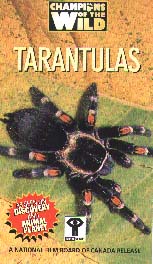|
________________
CM . . . .
Volume VI Number 16 . . . . April 14, 2000
Much maligned and misunderstood by people, tarantulas have remarkably
adapted to life in a variety of habitats around the world. They are native
to all continents but Antarctica, though, typically, they are associated
with desert locales. Most of this film's footage was taken in Arizona's
Sonora Desert. Amateur biologist Rick West has been fascinated by
tarantulas for over 30 years. He travels all over the world to find and
study these hairy arachnids whose name is derived from a wild Italian
dance, the tarantella, which is said to mimic the gyrations of a person
bitten by a tarantula. To dispel the myth of tarantulas being biters, West
claims that, in all his years of handling them, not once has he been
bitten.
The film takes viewers to the desert on a "tarantula safari" with West.
Research has to be done before sun-up, for temperatures can easily climb
to 120 degrees C during the day. West looks for a clue - spun silk -to
indicate the presence of an underground burrow's entrance. Having
discovered the entrance, he blows air through a tube into the hole to
check for the burrow's occupant and coaxes her out with a stick. Handling
the spider gently, West points out the various body parts and explains the
warning colours of several species. Tarantulas have two million hairs per
square centimeter. Special hairs can irritate or even blind an attacker.
Predators such as the grasshopper mouse, the roadrunner and the wasp
easily devour the spider, but the tarantula will fight certain predators
and has even been known to take on a snake.
When food is scarce, such as during a drought, tarantulas do not
reproduce, but, when moisture finally comes, the spiders begin to look for
mates. For the male, there is great danger in approaching the female. Like
the black widow, the female tarantula might eat her suitor shortly after
mating if he does not make a hasty getaway.
In a particularly graphic scene, the film shows a group of rainforest
dwelling Indians who eat tarantulas on a regular basis. First, they twist
off the spider's abdomen and squeeze its contents onto a leaf. Then they
roll up the leaf and place it on the fire (to act as rainforest
"briquettes"). Finally, they roast the rest of the spider and eat it.
After consuming two or three tarantulas, the Indians use the fangs to
clean their teeth (rainforest toothpicks).
In addition to the fabulous colour photography of tarantulas in their
natural habitats (and some extraordinary footage taken from inside an
occupied burrow, looking out), the camera takes viewers to West's basement
where he keeps 1500 live spiders as well as many "pickled" specimens. With
a sense of humour, he credits his wife's understanding of his passion for
these creatures and offers a few personal anecdotes of life in the West
household when one of his pets is "on the lam."
West is very concerned with the tarantulas' habitat being under siege and
their being exploited for the pet trade. Thanks to his efforts, nine
species have been declared endangered.
As with any nature film, the quality of the photography is paramount. This
video is no exception - fantastic close-up views of the spiders and their
habitats will keep viewers enthralled for the duration of the video and
leave them wanting more. Though the vocabulary in the narration might be
too advanced for youngsters below Grade 4 level, teachers could play the
video twice, once with narration and once with the volume turned off,
allowing teachers to do the voice-over to reinforce specific concepts. The
video is close-captioned (requires a decoder).
Inside the video case is a brief summary of the video as well as a few
pre-viewing and post-viewing questions. There is a short list of tarantula
websites and a list of other videos in the "Champions of the World"
series.
Highly Recommended.
Gail Hamilton is a teacher-librarian at Bird's Hill School in East St. Paul, MB.
To comment on this title or this review, send mail to cm@umanitoba.ca.
Copyright © the Manitoba Library Association.
Reproduction for personal use is permitted only if this copyright notice
is maintained. Any other reproduction is prohibited without
permission.
Published by
TABLE OF CONTENTS FOR THIS ISSUE - April 14, 2000.
AUTHORS |
TITLES |
MEDIA REVIEWS |
PROFILES |
BACK ISSUES |
SEARCH |
CMARCHIVE |
HOME
|
